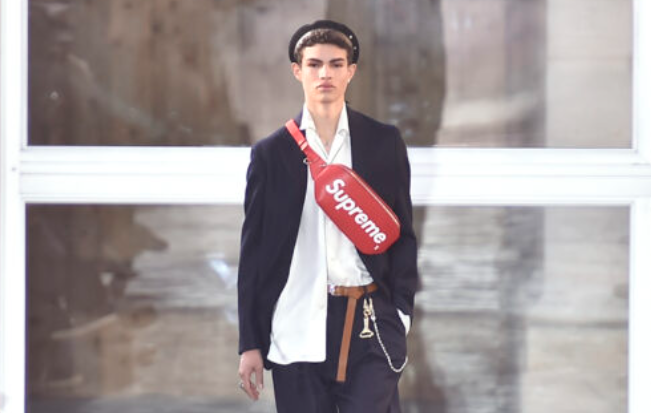Supreme has become synonymous with urban streetwear, a brand that transcends fashion to embody a cultural phenomenon. Founded in 1994 by James Jebbia in downtown Manhattan, Supreme Clothing has evolved from a small skate shop to a global icon. Now it will take you on a journey through the threads of Supreme style, exploring its history, significance, and the unique aura that sets it apart.
The Supreme Aesthetic:
Supreme is more than just a clothing brand; it’s an aesthetic, a lifestyle. The iconic red box logo, featuring the word Supreme in white Futura Heavy Oblique font, has become a symbol of exclusivity and urban cool. The brand’s limited-edition drops and collaborations with artists, musicians, and designers have elevated its status, creating a unique allure that captivates fashion enthusiasts worldwide.
The Supreme Hype Culture:
At the heart of the success of Supreme Clothing lies the hype culture it has masterfully cultivated. The brand’s strategic use of scarcity and exclusivity has turned each product drop into a cultural event. The anticipation, the limited quantities, and the frenzy that ensues have created a community of dedicated Supreme enthusiasts, forming a unique subculture within the broader fashion landscape.
The Collaborative Canvas:
One of the defining features of Supreme Clothing is its collaboration. The brand has partnered with some of the biggest names in fashion, art, and music. Whether it’s a limited-edition Supreme x The North Face jacket or a Supreme x Nike sneaker release, each collaboration is a unique piece of wearable art that merges two worlds, creating an item that transcends fashion and becomes a collector’s dream.
The Resale Revolution:
The hype around Supreme doesn’t end with the initial drop. The resale market for Supreme products is a thriving ecosystem of buying, selling, and trading. Limited quantities and high demand have turned Supreme pieces into coveted collector’s items, with some reselling for prices that far exceed their retail value.
Pop Culture of Supreme Clothing:
Supreme’s influence extends beyond fashion; it has become a symbol in pop culture. References to Supreme can be found in music lyrics, movies, and even in the world of art. The brand’s ability to seamlessly integrate into various facets of culture showcases its staying power and relevance in an ever-evolving landscape.
As Supreme continues to shape the fashion landscape, the question arises: What’s next for the brand? With its finger on the pulse of cultural shifts and a knack for reinvention, Supreme is poised to remain a dominant force in the world of streetwear.
Commitment to the Sustainability of Supreme Clothing:
In recent years, Supreme has not only been at the forefront of fashion trends but has also embraced a commitment to sustainability. As environmental awareness becomes increasingly crucial, Supreme has taken steps to incorporate eco-friendly materials into its designs. Collaborations with sustainable brands and the introduction of recycled fabrics showcase Supreme’s dedication to both style and responsibility.
Impact on Streetwear Culture:
The impact of Supreme Clothing on streetwear culture cannot be overstated. It has set the benchmark for authenticity, creativity, and a rebellious spirit that resonates with the younger generation. Many emerging streetwear brands draw inspiration from Supreme’s playbook, seeking to capture the essence of the urban cool that the brand has mastered.
Navigating the Supreme Clothing Drops:
For the uninitiated, participating in a Supreme drop can be an exhilarating yet challenging experience. The brand’s online releases often sell out within minutes, requiring a mix of strategy, patience, and a bit of luck. Online tutorials, guides, and dedicated forums have emerged to help newcomers navigate the fast-paced world of Supreme drops, ensuring that everyone has a fair shot at securing their coveted pieces.
The Supreme Lifestyle:
Supreme Clothing is not just about what you wear; it’s a lifestyle. From the bustling streets of New York to the fashion capitals of the world, Supreme has become a statement of identity. Whether you’re skateboarding through urban landscapes or attending a high-profile event, Supreme seamlessly adapts to diverse settings, embodying a style that is both versatile and distinctive.
FAQs
Who is Supreme owned by?
The brand produces skateboards along with its range of clothing and accessories. The distinctive red box logo, featuring the word “Supreme” in white Futura Heavy Oblique font, is widely believed to draw significant inspiration from the art of Barbara Kruger.
Who made Supreme Clothing Popular?
British fashion designer James Jebbia has left a significant mark on the streetwear landscape with his creation, Supreme. Established in 1994 within the vibrant streets of New York City.
Why is Supreme Clothing so famous?
Known for its free-spirited and playful essence, Supreme has achieved immense success, particularly resonating with a substantial younger demographic, often in their teenage years.

